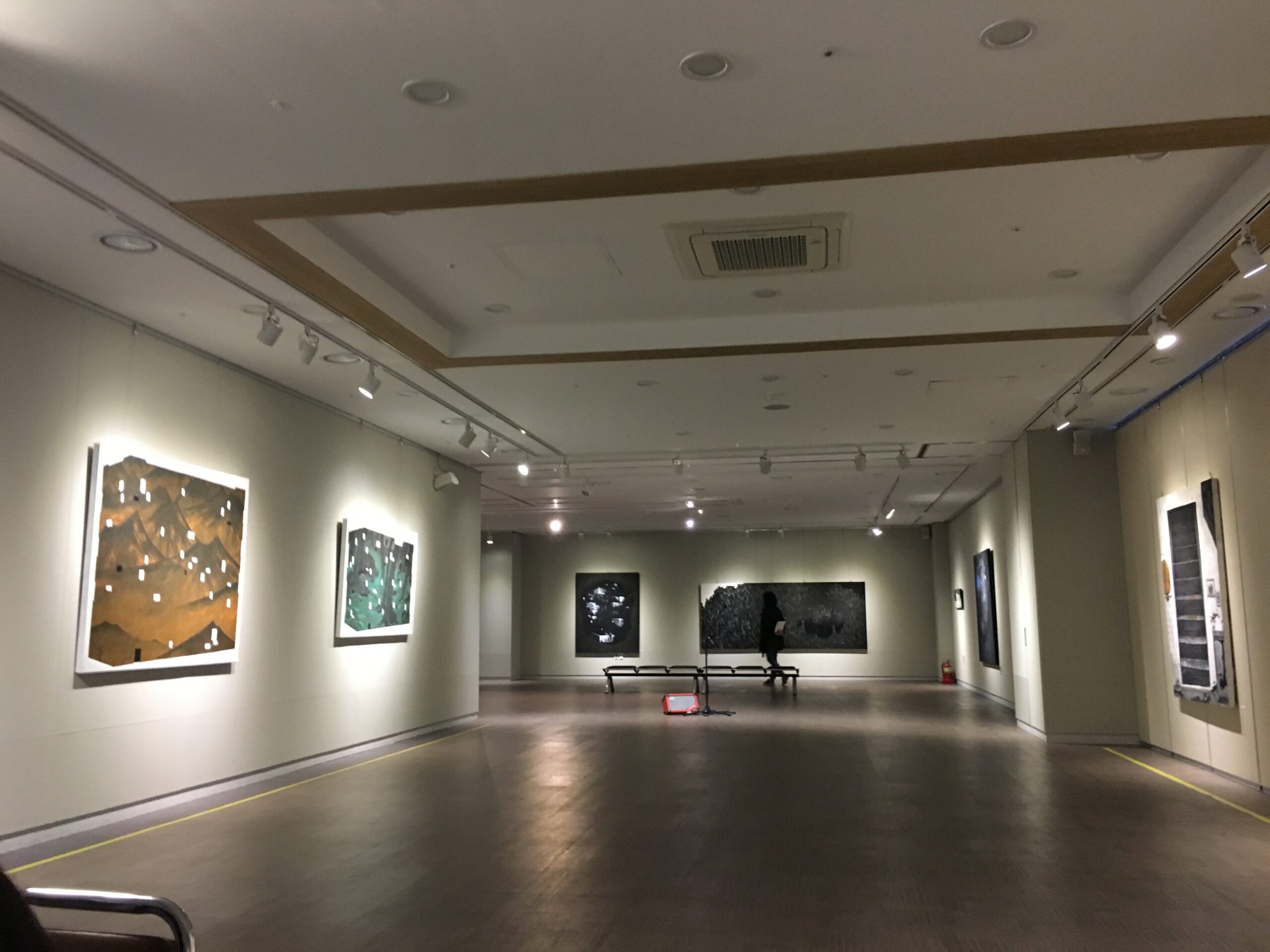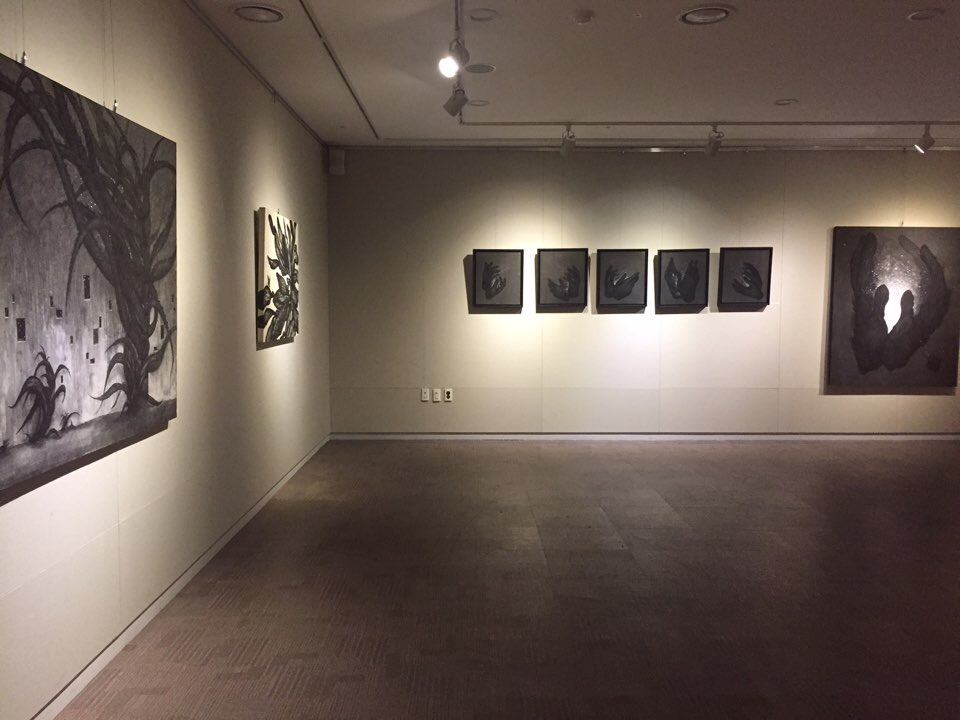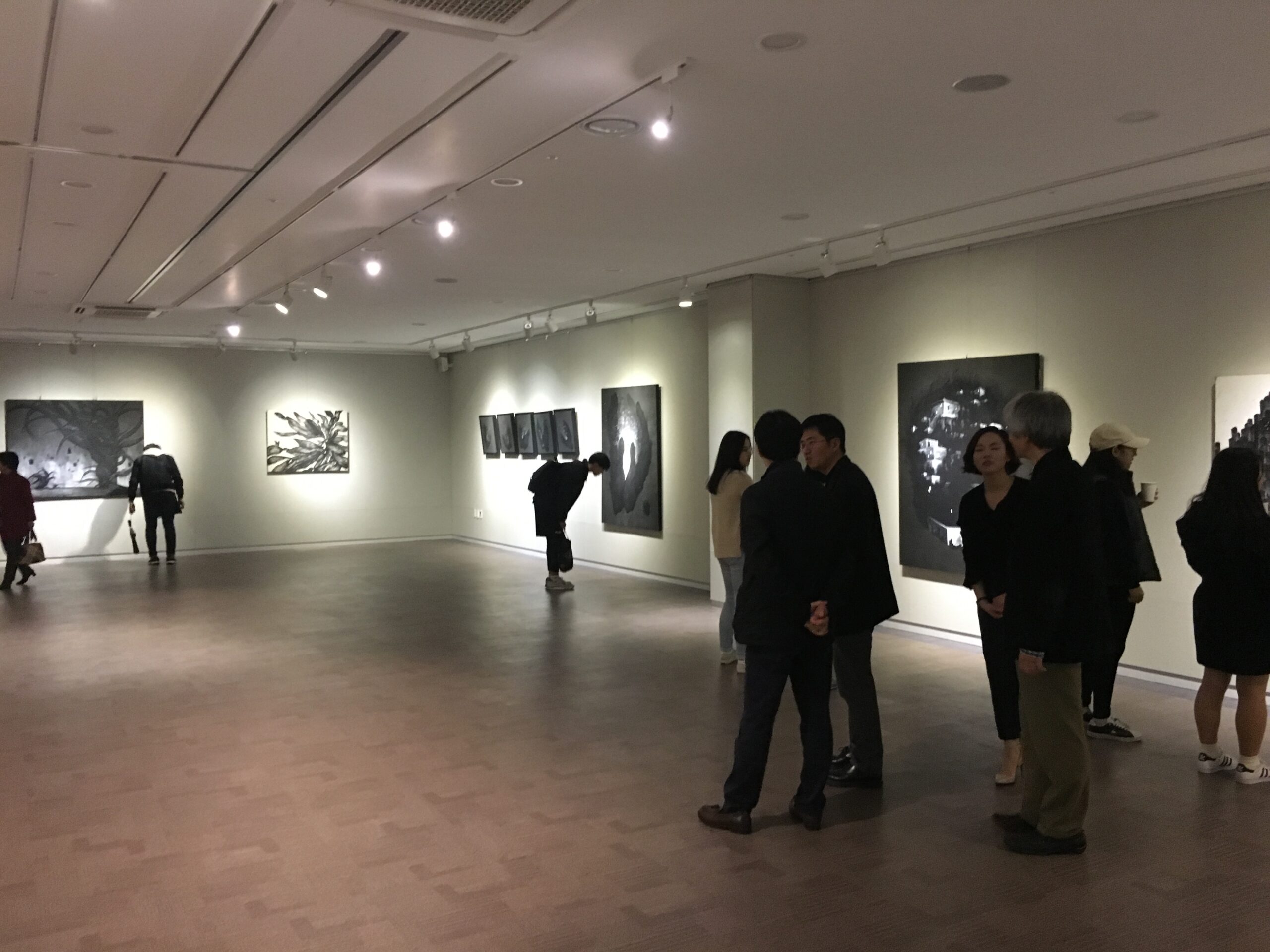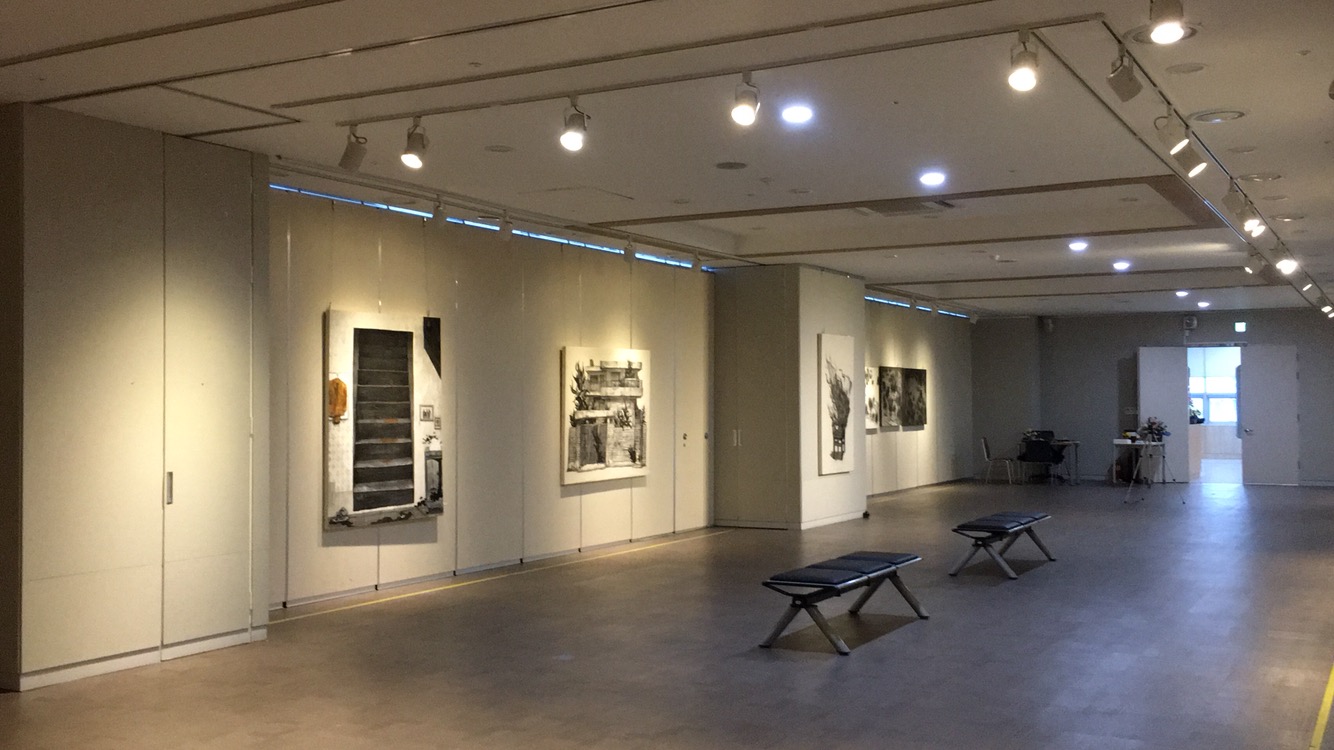






The Realisation of an Ideal Space in Subconscience through the Expression of Tenebrosity
「Another difficult day passes. I hastily pack up my steps which had been abandoned here and there in this jungle called the city. When that bitterness, already catching up with my strides and making its way into steps, permeates into my shadow, the cave in front of me opens slowly.
Tenebrosity.
I’m used to throwing out my hands to recollect a cold chair. Sighs, scattered around, and lethargic warmth brings back the pain of thorn in the pocket. Between thorns, swallowed one by one, black cactus rock around the room and the sound of a string-less harp blossoms and rubs against my warmed cheek. 」 The artist’s first impression of the ideal is thus obscure and dark. The ideal, the paradise is a sort of simulacra which men have created for escapist consolation. It does not exist and yet feels real, sometimes more real than things which do exist. For Hong yoojoo, the room is a time space where simulation creates this simulacre. The artist, through dream which is a direct simulation, relates memories and consciousness about various events to her subconscious. To the artist, dream is a direct medium which refines information from the real world into a state of loss and oblivion, realizing a sense of identity in subconscious. This is reproduced as a real desire for expression, a realisation of the ideal as a time of rest and space of comfort, through tenebrous colours on canvas. What the artist so strongly desired to reveal, her subconscious, is a voluntary signal to reestablish out of repressed boundaries; the unrecognized, dormant consciousness of the artist germinates under certain circumstances. So rather than being a subconscious, it is a sense of identity which had long been repressed – a code which seeks to recognise the reality under oppression and to regain free will from repression. It is a healing ritual, a sacrament of regeneration. The artist’s works show objects and spaces that are always dark and obscure. They are scarily serene and silent. Those are the most significant feature of Hong’s works. Silent situations, like serenity, make us feel foreign and fear. And yet, incomplete emotions and serenity in the conscious sometimes lead to the extinction of that incompleteness. This can be compared to a certain period of stillness required to eliminate all waves from the surface of water after an impact. Thus the artist’s quietness in darkness represents rest.
“Darkness, like cactus which has grown quietly in my room, comes across as an alien and scary figure; but in a moment it fills up the space and breaths with me.”
“Low light creates various colours thorough sense, consciousness and change in space; night, then, is the space beyond the conscious where the original form, without phenomena, is visible.” Thus spoke the artist.
This silent space of tenebrosity, which the artist recognizes as darkness, represents a place of perfect refuge; an absolutely independent space, a safe haven granted only to the self. This resembles the peace of the origin of the world or the mother’s womb, a space of calm. As such, for the artist, this is a space of self-purification where inner sense of loss, repression, as well as all memories and senses of reality, are eradicated; it is also a space of restoration where zero-vibration returns the self to a zero state. This complex is what the artists means by paradise, the ideal space. In order to express this space, the artist “uses cotton cloth for warmth and softness, conte and charcoal for freedom and flexibility, and ink powder and ink stone for that deep and warm darkness.” Softness, warmth, freedom, and flexibility are psychological expressions which the artist seeks to give to the space. Hong’s expressive intentions show that the negative images of tenebrosity are turned around, put to ironic methods in approach. Here, the artist reverses a contrast between two opposing concepts through the ideal space. We often see two opposing concepts forming a harmony to produce new values in nature. The nature’s power of harmony creates life, whose meaning has always served as the basis of humanity’s realisation of self-value. Hong, through the expression of tenebrosity which aspires to the ideal space, hints at this natural mechanism; this is because the vitality of purification and restoration is shown in the artist’s own life. That sense of relative loss and loneliness which one feels when one expands one’s life, either independently or through organic relations with society, darkens and depresses the life of modern humanity because we simply cannot give up on such expansion. I hope that the exhibition allows us to take full helpings of that meaning of life which Hong wishes to restore for us.
Tea-Heyng JANG
암연의 표현을 통한 잠재의식 속 이상공간의 구현
「 그리 녹록치 않았던 하루가 지나간다. 그 사이 도시라는 숲속에 여기저기 버려두었던 내 발자국을 서둘러 구겨 담는다. 어느새 따라잡힌 걸음사이를 비집고 들어와 버린 쓴웃음이 내 그림자에 스며들 때 즈음 눈앞에 서서히 동굴의 문이 열린다.
암연(黯然)
그 안에 익숙하게 손을 던져 식어버린 의자를 기억해 낸다. 힘없이 널브러진 한숨과 나른한 온기로 되살려낸 주머니 속 가시가 아려오기 시작한다. 하나씩 하나씩 삼켜버린 가시들 사이로 검은 선인장이 방 안에 일렁이면 막 피어나는 무현금 소리가 다가와 뜨거워진 내 볼을 비벼댄다. 」
작가가 설명하고 있는 이상향의 첫 느낌은 이처럼 매우 기괴하고 암울한 모습으로 그려진다. 이상향 즉 유토피아나 무릉도원은 불안정한 현실세계에서 벗어나 위안을 얻고자 인간인 만들어낸 일종의 시뮬라크르(Simulacra)이다. 즉 존재하지 않지만 존재하는 것처럼, 때로는 존재하는 것보다 더 생생하게 인식되는 것이다. 홍유주 작가에게 밤은 이 시뮬라크르를 생성시키는 시뮬라시옹(Simulation)이 작용되는 시공간이다.
작가는 일상 속 다양한 사건에 대한 기억과 의식을 꿈(夢)이라는 직접적인 시뮬라시옹을 통해 무의식속에 내재된 자신의 욕망을 잠재의식과 연계시킨다. 또한 작가에게 꿈은 현실에서 얻어진 정보를 상실과 망각의 상태로 정제시켜 잠재의식 속 자의식을 구체화 시키는 직접적인 매개체로 활용 되며, 이것은 화면위에 암연의 색채를 통해 안식의 시간, 위안의 공간인 이상향을 재현시키는 실질적인 표현의지로써 재생산 된다.
작가가 그토록 드러내고자 하는 자신의 무의식이라는 것은 아마도 인식 되지 않고 잠재되었던 작가의 하나의 의식이 특정한 조건에서 발아되어, 억압된 경계를 벗어나 재정립되려는 자발적인 신호(signal)와 같다. 즉 무의식이라기보다는 드러나지 않은 일종에 억압되어있던 자의식이며, 짓눌려 버린 현실의 인식과 억압된 자유의지를 복구하려는 일종의 코드로 치유의식 또는 재생의식이라 말 할 수 있다.
작가가 제시하는 이상향 속 숨겨진 신호를 따라가 보면 크게 숲, 건물, 방, 의자와 선인장 그리고 손을 이용한 네 가지 장면으로 자신의 이상향으로 향하는 길을 설명하고 있다. 간략히 들여다보면 화면 속엔 잊고 싶은 현실의 숲길을 지나 저 멀리 나지막한 언덕이 보인다. 그 언덕 너머에는 유일한 그녀의 도피공간인 한 건물이 존재하며, 그곳은 무릉도원이나 유토피아에서 얻어지는 화려함이나 세련됨과는 거리 먼 낡고 평범한 보통의 집이다. 작가가 동굴이라 부르는 그곳의 문을 열고 들어간 그 자리에는 또 하나의 독립된 공간인 방이 있다. 그 안에는 자신이 유일하게 의지할 수 있는 의자가 놓여있고 그 옆에는 작가의 의식들을 먹고 자라는 선인장이 있다.
그런데 작가의 작품 속 사물과 공간은 늘 흐리고 어둡다. 또한 무서울 만큼 고요하고 정적이다. 이것이 홍유주 작가 작품에 보이는 가장 큰 특징이다.
고요함과 같은 무성(無聲)의 상황에서 느껴지는 인간의 감정은 낯설음과 두려움이겠지만 불완전한 감정과 인식 상태에서의 고요함은 때론 그 불완전함의 소멸을 유도해 내기도 한다. 이는 충격에 의한 수면(水面)위의 파장이 사라지기 위해 일정부분의 조건만큼 무진동상태가 필요한 것에 비유될 수 있다. 이처럼 작가가 표현하는 어둠속 내재된 고요함의 의미는 안식(安息)이다.
“ 어둠은 조용히 자라난 내 방안 선인장과 같이 낯설고 두려운 형상으로 다가오지만 어느새 그 공간을 가득 채워 나와 같이 숨을 쉬고 있다.”
“ 낮은 빛에 의하여 다양한 색을 분출해내는 감각이나 의식 그리고 변화의 공간이라면, 밤은 현상이 없는 본래의 모습이 보이는 의식 너머 공간이다.” 라고 작가는 말한다.
작가에게 어둠으로 인식되고 있는 적막(寂寞)한 암연의 공간은 완벽한 안식처의 의미로써 자신에게만 허용된 절대적인 독립공간이자 안전지대로 이해된다. 이는 작가가 느꼈을 태초의 평온함과 고요의 공간인 어머니의 자궁(子宮)과 같은 것이다. 이 무한한 포용과 사랑의 공간에서 작가 자신은 내재된 모든 감정을 쏟아내어 그 모두를 정화시키고 치유시킴으로써 살아 있음을 느꼈을 것이다. 이러한 의미에서 작가에게 이 공간은 내재된 상실감과 억압감 그리고 현실 속 모든 기억과 감각들을 소멸시키는 일종의 자정공간(自淨空間)이 되며, 자신을 완벽하게 원점(zero)의 상태로 복원시키는 무진동의 환원공간(還元空間)이 되는 것이다. 이 복합공간이 작가가 말하는 무릉도원이자 유토피아인 이상공간(理想空間)이다.
작가는 이곳을 표현하기 위해 “부드럽고 따뜻한 느낌을 드러내는 재료로 광목을 이용하며, 자유로움과 유연함을 표현하는 재료로 콩테와 목탄을 사용하고 깊고 따스한 어둠을 표현하기 위해 분채와 먹을 혼용하고 있다.”라고 설명한다.
부드러움, 따뜻함, 자유로움, 유연함 등은 이 공간에 부여하려는 작가의 심리적 표현의도다. 표현의도에서만 보더라도 적막한 암연에서 생산되는 부정적 이미지를 매우 역설적이고 반어적인 방법으로 접근하고 있음을 이해할 수 있다. 이것은 작가가 이상공간을 통해 대비되는 두 개념의 의미를 역으로 제시하여 혼융시키고 있는 것이다.
상반된 두 개념이 하나로 조화되어 새로운 가치를 창출하는 것 우리는 이러한 모습을 자연의 조화적 특성에서 쉽게 발견할 수 있다. 자연이 지닌 조화의 능력에서 생산되는 생명의 의미로부터 인간은 늘 스스로의 가치를 파악해 왔다.
홍유주 작가의 암연의 표현을 통한 이상공간에서 이러한 자연의 본의를 유추할 수 있음은 작가 자신의 삶에서 드러나는 자정과 환원의 생명력이 화면에 베어 나오고 있기 때문일 것이다.
자신의 삶을 독립적으로 또는 사회와 유기적으로 확장시킬 때 받게 되는 상대적인 상실감과 외로움은 이것을 포기 할 수 없는 현대인들의 삶을 어둡고 침울하게 만들곤 한다. 이 전시를 통해 그녀가 우리들에게 되돌려 주려하는 생명의 의미를 마음껏 담아가길 기대해 본다.
장 태영
Ping : MyBlog
Ping : livraison le lendemain kamagra
Ping : enclomiphene fedex delivery
Ping : how to buy androxal canadian online pharmacy
Ping : cheap flexeril cyclobenzaprine generic is it legal
Ping : does dutasteride really work
Ping : purchase fildena canada mail order
Ping : is there anything over the counter like gabapentin
Ping : how to buy staxyn cheap from canada
Ping : generic itraconazole in brazil
Ping : buy avodart generic how effective
Ping : cheapest generic rifaximin uk
Ping : how to get it up without xifaxan
Ping : kamagra bez dr